

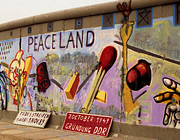
The Berlin Wall came down at the end of 1989. A year later we took the night train to Berlin to see what was happening in the city.
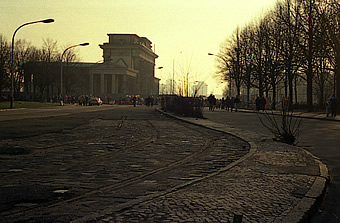
There has been a town on the right bank of the River Spee since the thirteenth century. It grew into a city of merchants and eventually became the capital of Germany. During the Second World War much of the city was destroyed. At the end of the war Germany was divided into four sectors governed by the British, USA, France and the USSR. Berlin was similarly divided. In 1948 the Soviets imposed a blockade, blocking access by the Western powers to the three sectors of Berlin which they governed - no freight was able to move by road, rail or water. No such restrictions could be placed on aircraft, however, and the blockade was overcome by the Berlin Airlift, flying goods to the beleagured inhabitants. The success of the airlift was an embarassment to the Soviets, who eventually removed the blockade in May 1949.
Cold War tensions had escalated since the end of the war and in 1949 the western allies merged their zones to form the Federal Republic of Germany, including their western zones of Berlin. The Soviet zone, including east Berlin, became the German Democratic Republic. A border thus came into being, not only between east and west Germany but between east and west Berlin. As the situation worsened the border between East and West Germany was closed, but that between East and West Berlin remained open until in 1961 this border too was closed and construction of the Berlin Wall began. Berlin, completely surrounded by the GDR, was encircled by a physical barrier. Despite Soviet claims to the contrary, the wall was essentially a means of stopping East Germans escaping to the West.
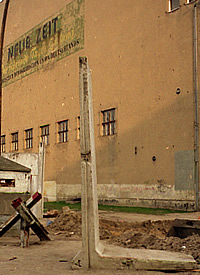
By 1989 Communism was no longer viable in East Germany. On the 9th of November the Wall was breached. The scenes were jubilant as East Berliners were freely able to cross into West Berlin and sections of the wall were torn down. East Germany and its politics were demolished along with the Wall and on the 3rd of October 1990 the two Germanies united to form, once more, a single country.
On the 7th December, 1990, just two months after the unification of Germany, we took the night train from Basel to see what was happening in the city. We had no idea what to expect but found a city with lots of budding entrepreneurs - selling off bits of the Wall and lots of Military items, mostly uniforms. We'd heard there was strong anti-Russian feeling but didn't actually see any of this - we met some very jovial Russians who persuaded me to buy a Russian ice hockey shirt (it's languished in a drawer ever since!).
On arrival we had breakfast in a cafe near the station, later in our visit we had lunch at Ka De We and in both places the waiting staff were extremely rude and yelled at customers (not us thankfully). One evening we tried to get tickets to go to a concert and went to the wrong place - the receptionist here was also extremely unpleasant. Yet one evening we had a meal in Kempinski's and arrived in a downpour - the waitress couldn't have been nicer providing lots of serviettes to dry my hair. Excellent meal too!
We stayed at the Hotel Metropole, a 5 star hotel at 150-153 Friedrichstrasse - a block of a building but OK for a few nights. At breakfast we could see across the street some kind of factory belching black fumes! It was just north of Checkpoint Charlie on Friedrichstrasse, so technically we were staying in "East Berlin". Checkpoint Charlie was the famous border crossing between East and West Berlin for foreigners and Allied Forces military personnel. We went to the interesting little museum at Checkpoint Charlie, well worth a visit, mainly about escape attempts.

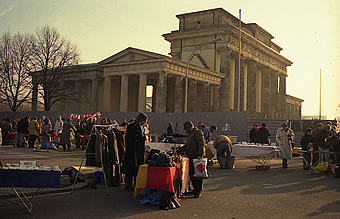
Our first day we went out to the Brandenburg Gate via Unter den Linden - a beautiful wide boulevard named for the lime trees which line it. The Brandenburg Gate used to be on the other side of the Wall in East Berlin but is now accessible. One of the few buildings not to be severely damaged or destroyed in the Second World War, it was commissioned as a peace symbol by Kaiser Friedrich Wilhelm I. At the time of our visit the famous four horse chariot or Quadriga had not been restored to its position on top of the gate.
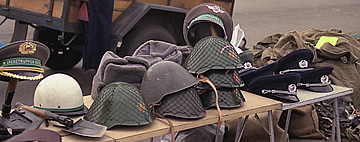
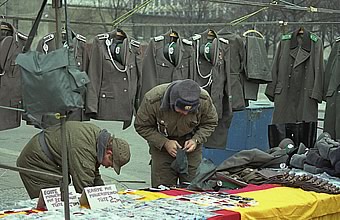
All around were people selling all kinds of stuff from makeshift stalls: Russian Matryoshka dolls - those which open to reveal another doll - gas masks, tools and stacks of military uniforms. There were also supposedly bits of the Wall for sale, with supporting photographs, but whether these were real or not we couldn't tell.
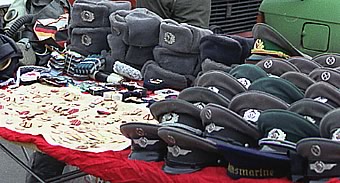

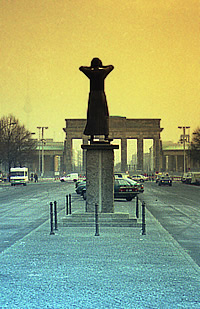
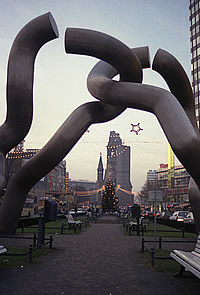
On Strasse des 17 Juni there is a wonderful statue of a girl facing the Brandenburg Gate - she looks as though she is calling into the East. I found out from this website that this lovely statue is "The Caller" / "Der Rufer" by Gerhard Marcks; inscription on the pedestal: "I pace through the world and exclaim peace peace peace".
Another fine modern sculpture, this one by Brigitte and Martin Matschinsky-Denninghof, on Tauentzien Strasse is "Berlin", 1987, so created before the Wall came down. It marked the city's 750th anniversary. Aside from being a very striking sculpture, it beautifully frames the Kaiser Wilhelm Gedächtniskirche or Memorial Church which was badly damaged in the Second World War and left as a memorial.

The Tiergarten is a vast park with, at its centre, the Victory Monument, the Siegessäule, a monument which also survived the war virtually unscathed. It commemorates Prussian victories at the end of the nineteenth century and at 67m high it can be seen from quite a distance.

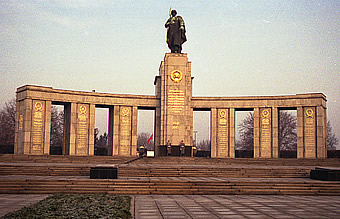
The temperature was of the nostril-freezing variety - unbelievably cold. At times I couldn't feel my feet and had to stamp up and down the pavements to make sure they didn't die on me.
At the Russian Memorial I was almost too cold to take photographs. It's an impressive Memorial, with a fine statue of a Russian Soldier and nearby the first two Soviet tanks to enter the city. The memorial was guarded by two Russian soldiers guarded by two German soldiers!
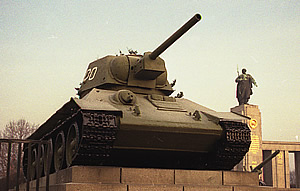
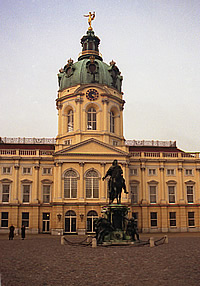
We travelled the U-Bahn a lot around the city. It was very scruffy, the machines didn't always work, everyone looked miserable and there were lots of tramps - but then the same could be said of the Tube in London! One day we made our way to Alexanderplatz in the old East Berlin. The nearby streets were depressing: sad, grey buildings, and the vast square itself bleak in the extreme, especially in the rain, just a sea of concrete.
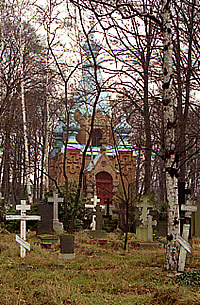
One morning we took the U-Bahn to Holzhauser Strasse to see the Russian Orthodox Church, very peaceful and not vandalised - not even any graffitti. The church was built in 1894 and is made of brick with beautiful blue cupolas
We visited Chaussee Strasse where there used to be a border crossing, it is all very bleak but interesting - in some places it felt like walking back in time 50 years, which, I suppose, isn't surprising! All apartment blocks, no grass or trees except in a cemetery. On to Bernauer Strasse where the wall has gone but the memorials remain - this is where the official demolition began in June 1990. It was very atmospheric, but also cold and wet so we retreated to Ka De We for lunch.
We were cheered up by a visit to Charlottenberg Palace in the west of the city, built in 1699 and the favourite of Queen Sophie-Charlotte, wife of Friedrich Wilhelm I. Much enlarged during the following century, the building exterior is beautiful but the interior is very much in the baroque style which is not to my taste at all. However, a highlight was discovering the famous painting (one of five versions) of "Napoleon crossing the Alps" by Jacques Louis David.
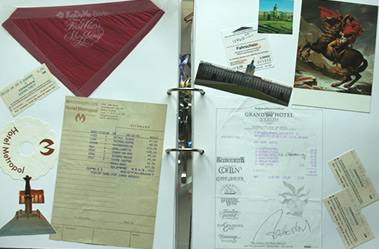
We tried to find Hitler's Bunker, south east of the Reichstag and Brandenburg Gate. Not sure we were in the right place but there was a film crew there who also seemed to think they were at the correct location. Now it is just a huge desolate patch of ground with a bump in it where we think the bunker was and a wide road where the Wall used to be.

Just south of here we found large sections of Wall.
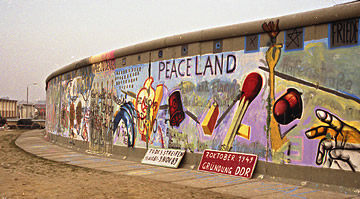
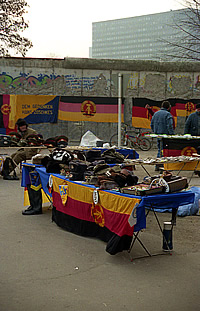
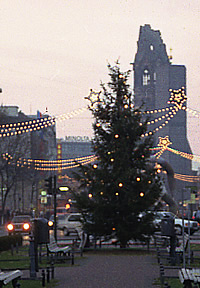
Again here there were many stalls selling items of military uniforms.
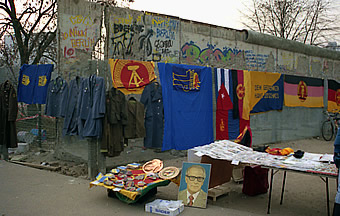
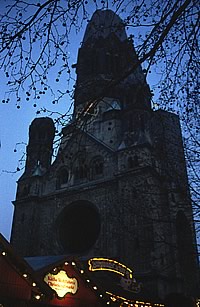
One cheerful aspect of the city at this time was the Christmas Market.
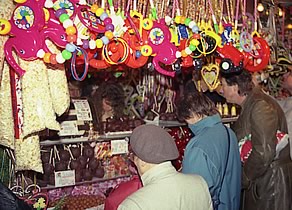
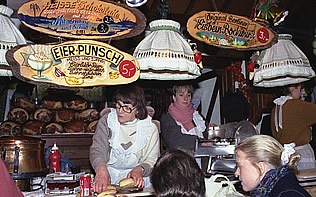
Christmas lights strung around the roofs of the little hut-style stalls selling Christmas goods and near the Kaiser Wilhelm Memorial Church a line of stalls selling lots of different types of food.
For more information on the history of Berlin and the Berlin Wall these websites may be useful - no responsibilty is taken for the content of external websites:
http://www.berlin.de/berlin-im-ueberblick/geschichte/1945.en.html
http://www.berlin.de/mauer/geschichte/index.en.html
http://news.bbc.co.uk/onthisday/hi/dates/stories/november/9/newsid_2515000/2515869.stm